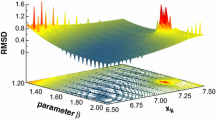Abstract
Using the set of trial spinors\(\left\{ {N_i \left( {_{\hat \Omega _i u_i }^{u_i } } \right), i = 1, \ldots , N} \right\}\) and the Dirac-Coulomb Hamiltonian (H DC) we discuss the role of the minimax theorem in relativistic Hartree-Fock calculations. In principle, the minimax theorem guarantees the occurrence of an upper bound. We also consider a scaling of the functionsu i and discuss the condition to derive the relativistic hypervirial theorem; the variational procedure represented by the condition serves as an example of the minimax technique. Single zeta calculations onH +2 ,H 2 and He are analysed. The effect of enlarging the basis is investigated for the He atom. The “upper bound” obtained by usingcoherent basis spinors differs from the result of the (random) linear variation using the kinetically balanced basis set by an amount which is at most of orderc −4. Use of thecoherent basis set is advocated.
Similar content being viewed by others
References
Datta S N 1980Chem. Phys. Lett. 74 568
Datta S N 1984Pramana — J. Phys. 23 L275
Datta S N 1987Pramana — J. Phys. 28 633
Datta S N and Devaiah G 1986 in: Abstract of the Conference on relativistic many-body problems, Trieste (Italy)
Datta S N and Ewig C S 1982Chem. Phys. Lett. 85 443
Datta S N and Jagannathan S 1984Pramana — J. Phys. 23 467
Desclaux J P 1973At. Data Nucl. Data Tables 12 311
Drake G W F and Goldman S P 1981Phys. Rev. A23 2093
Dyall K G, Grant I P and Wilson S 1984J. Phys. B17 L45, 439
Epstein S T 1974The variation method in quantum chemistry (New York: Academic Press)
Fock V A 1978Fundamentals of quantum mechanics (Moscow: Mir Publishers)
Gazdy B 1983Chem. Phys. Lett. 99 41
Gazdy B and Ladanyi K 1984J. Chem. Phys. 80 4333
Goldman S P 1985Phys. Rev. A31 3541
Grant I P 1986J. Phys. B19 3187
Hegarty D 1986Theor. Chim. Acta 70 351
Hess B A 1986Phys. Rev. A33 3742
Ishikawa Y 1986 in: Abstract of the Conference on relativistic many-body problems, Trieste (Italy)
Ishikawa Y, Binning R C and Sando K M 1983Chem. Phys. Lett. 101 111
Ketley I J and Moss R E 1983Mol. Phys. 48 1131
Kim Y K 1967Phys. Rev. 154 17
Kutzelnigg W 1984Int. J. Quantum Chem. 25 107
Laaksonen L and Grant I P 1984aChem. Phys. Lett. 109 485
Laaksonen L and Grant I P 1984bChem. Phys. Lett. 112 157
Ladik J, Cizek J and Mukherjee P K 1983Relativistic effects in atoms, molecules and solids (ed.) G Malli (New York: Plenum Press) p. 305
Lee Y S and Mclean A D 1982J. Chem. Phys. 76 735
Malli G 1984J. Chem. Phys. 80 2060
Mark F and Schwarz W H E 1982Phys. Rev. Lett. 48 673
Matsuoka O, Suzuki N, Aoyama T and Malli G 1980J. Chem. Phys. 73 535
Mittleman M H 1981Phys. Rev. A24 1167
Morrison J D and Moss R E 1980Mol. Phys. 41 491
Oreg J and Malli G 1976J. Chem. Phys. 65 1663
Pavlik P I and Blinder S M 1967J. Chem. Phys. 46 2749
Rosicky F and Mark F 1975J. Phys. B8 2581
Rutkowski A 1986 in: Abstract of the Conference on relativistic many-body problems, Trieste (Italy)
Schwarz W H E 1987Phys. Scr. 36 403
Schwarz W H E and Wallmeier H 1982Mol. Phys. 46 1045
Schwarz W H E and Wechsel-Trakowski E 1982Chem. Phys. Lett. 85 94
Sepp W D and Fricke B 1985AIP Conf. Proc. 136 20
Stanton R E and Havriliak S 1984J. Chem. Phys. 81 1910
Sucher J 1980Phys. Rev. A22 348
Sucher J 1985AIP Conf. Proc. 136 1
Wood J, Grant I P and Wilson S 1985J. Phys. B18 3027
Author information
Authors and Affiliations
Additional information
An erratum to this article is available at http://dx.doi.org/10.1007/BF02846961.
Rights and permissions
About this article
Cite this article
Datta, S.N., Devaiah, G. The minimax technique in relativistic Hartree-Fock calculations. Pramana - J. Phys. 30, 387–405 (1988). https://doi.org/10.1007/BF02935594
Received:
Revised:
Issue Date:
DOI: https://doi.org/10.1007/BF02935594




